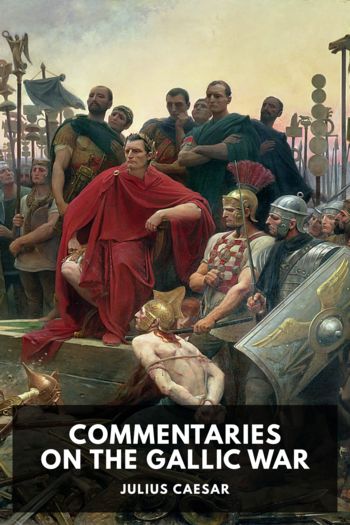Fateful Lightning: A New History of the Civil War & Reconstruction by Allen Guelzo (icecream ebook reader txt) 📗

- Author: Allen Guelzo
Book online «Fateful Lightning: A New History of the Civil War & Reconstruction by Allen Guelzo (icecream ebook reader txt) 📗». Author Allen Guelzo
True to the omen of the eclipse, it was at this point that the entire doctrine of popular sovereignty began to come unraveled.
When Stephen Douglas spoke of popular sovereignty, it was clear that he imagined a peaceful territory filling up gradually with contented white settlers (and evicting, if necessary, any contented Indian inhabitants); eventually there would be enough white settlers on hand to justify an application for statehood and the writing of a state constitution. “The true intent and meaning of this act [is] not to legislate slavery into any territory or state, nor to exclude it therefrom, but to leave the people thereof perfectly free to form and regulate their domestic institutions in their own way.” Beyond that, no one—especially not in Washington—had any business second-guessing the popular will. If a territory, declared Douglas, “wants a slave-State constitution she has a right to it… I do not care whether it is voted down or voted up.”44
It seems never to have occurred to Douglas before Kansas-Nebraska that popular sovereignty might also mean that if a majority of anti-slavery settlers could camp in Kansas or Nebraska before any equal numbers of slaveholding settlers (or vice versa), that simple majority would determine the slave or free status of the territory and its future status as a state. Douglas also ignored the possibility that there might be other ways, not necessarily gradual and painless, of achieving majorities.
This, of course, is precisely what happened in the new Kansas Territory. Antislavery New Englanders organized a New England Emigrant Aid Society in the summer of 1854 to send trains of armed anti-slavery Northerners to Kansas; in Missouri, bands of armed pro-slavery whites crossed over the border into Kansas to claim it for slavery. In the process, both sides learned yet another way of creating majorities, namely, by killing off one’s opponents, and so a fiery sparkle of violent clashes and raids between pro-slavery and anti-slavery emigrants danced along the creeks and rivers of the new territory. And by the time a territorial governor, Andrew Reeder, had been dispatched by Congress to supervise a preliminary territorial election, the Missourians had developed yet another variation on popular sovereignty—sending “border ruffians” over into Kansas on voting days to cast illegal ballots.45
The situation only grew worse in the spring of 1855, when Governor Reeder called for elections to create a territorial legislature for Kansas. The “border ruffians” crossed over in droves to vote for pro-slavery candidates for the legislature, and when the balloting was over and some 5,400 votes for pro-slavery candidates had materialized from the 3,000 eligible white male voters of the Kansas Territory, it was clear that the election had been stolen. The beleaguered Governor Reeder was too intimidated by the “border ruffian” gangs to invalidate the election, and the new legislature, ignoring Reeder’s vetoes, enacted a territorial slave code so severe that even verbal disagreement with slavery was classified as a felony. President Pierce, still staked to popular sovereignty, refused to take any action.46
The angered free-soil settlers at once feared for the worst from their new legislature, and so they armed and fortified the free-soil town of Lawrence. They also organized a rival anti-slavery legislature and wrote a free-state constitution. In May 1856 the reckless and arrogant pro-slavery legislature responded by equipping a small pro-slavery army that sacked and burned Lawrence. “Gentlemen,” boasted one of the pro-slavery leaders, “this is the happiest day of my life. I determined to make the fanatics bow before me in the dust… and I have done it—by God, I have done it.”47 Overall, two hundred people were killed in clashes between pro-slavery and antislavery factions in Kansas before President Pierce finally sent in John White Geary, a former army officer, as territorial governor. A more skilful arbitrator than Reeder, Geary was at last able to bring a measure of peace to what had become known to the rest of the country as “Bleeding Kansas.”48
What happened in Kansas was disturbing evidence that Douglas’s fix-it of popular sovereignty was no help whatsoever in sorting out the complex problem of allowing the expansion of slavery into the territories. Far from bringing peace, popular sovereignty in Kansas had only brought Americans two of the most spectacular scenes of violence they had ever witnessed outside of outright war. One of them occurred in Kansas itself. A Connecticut-born abolitionist named John Brown, a man with the selfless benevolence of the evangelicals wrought into a fiery determination to crush slavery, became convinced from the reports he had heard that five anti-slavery men had died in the sack of Lawrence. Brown had moved to Kansas only in 1855, but already he had been elected captain of a free-state militia company. Seeking an eye for an eye after the sack of Lawrence, Brown, with four of his sons and two neighbors, went on a murderous rampage along Pottawatomie Creek on May 24, 1856. They dragged five pro-slavery farmers from their beds and from the arms of their wives and deliberately hacked





Comments (0)